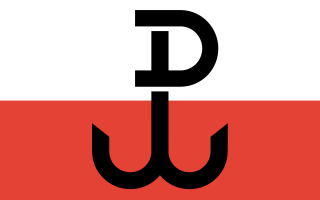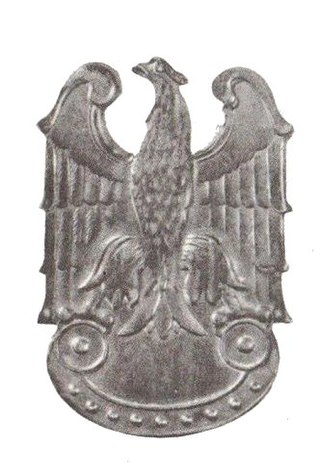Related Research Articles

The Home Army was the dominant resistance movement in German-occupied Poland during World War II. The Home Army was formed in February 1942 from the earlier Związek Walki Zbrojnej established in the aftermath of the German and Soviet invasions in September 1939. Over the next two years, the Home Army absorbed most of the other Polish partisans and underground forces. Its allegiance was to the Polish government-in-exile in London, and it constituted the armed wing of what came to be known as the Polish Underground State. Estimates of the Home Army's 1944 strength range between 200,000 and 600,000. The latter number made the Home Army not only Poland's largest underground resistance movement but, along with Soviet and Yugoslav partisans, one of Europe's largest World War II underground movements.

The Polish Workers' Party was a communist party in Poland from 1942 to 1948. It was founded as a reconstitution of the Communist Party of Poland (KPP) and merged with the Polish Socialist Party (PPS) in 1948 to form the Polish United Workers' Party (PZPR). From the end of World War II the PPR ruled Poland, with the Soviet Union exercising moderate influence. During the PPR years, the conspiratorial as well as legally permitted centers of opposition activity were largely eliminated, while a communist system was gradually established in the country.

The Polish Underground State was a single political and military entity formed by the union of resistance organizations in occupied Poland that were loyal to the Government of the Republic of Poland in exile in London. The first elements of the Underground State were established in the final days of the German and Soviet invasion of Poland, in late September 1939. The Underground State was perceived by supporters as a legal continuation of the pre-war Republic of Poland that waged an armed struggle against the country's occupying powers: Nazi Germany and the Soviet Union. The Underground State encompassed not only military resistance, one of the largest in the world, but also civilian structures, such as justice, education, culture and social services.

People's Army was a communist Soviet-backed partisan force set up by the communist Polish Workers' Party (PPR) during World War II. It was created on the order of the Polish State National Council on 1 January 1944. Its aims were to fight against Nazi Germany in occupied Poland, support the Soviet Red Army against the German forces and aid in the creation of a pro-Soviet communist government in Poland.

Gwardia Ludowa or GL was a communist underground armed organization created by the communist Polish Workers' Party in German-occupied Poland, with sponsorship from the Soviet Union. Formed in early 1942, within a short time Gwardia Ludowa became the largest clandestine fighting force on Polish soil which refused to join the structures of the Polish Underground State loyal to the London-based government-in-exile. In the January 1 of 1944 GL was incorporated into the communist Armia Ludowa.

Peasant Battalions was a Polish resistance movement, guerrilla and partisan organisation, during World War II. The organisation was created in mid-1940 by the agrarian political party People's Party and by 1944 was partially integrated with the Armia Krajowa. At its height, in summer 1944 the organisation had 160,000 members.

The Polish Committee of National Liberation, also known as the Lublin Committee, was an executive governing authority established by the Soviet-backed communists in Poland at the later stage of World War II. It was officially proclaimed on 22 July 1944 in Chełm, installed on 26 July in Lublin and placed formally under the direction of the State National Council. The PKWN was a provisional entity functioning in opposition to the London-based Polish government-in-exile, which was recognized by the Western allies. The PKWN exercised control over Polish territory retaken from Nazi Germany by the Soviet Red Army and the Polish People's Army. It was sponsored and controlled by the Soviet Union and dominated by Polish communists.

Milicja Obywatelska, in English known as the Citizens' Militia and commonly abbreviated to MO, was the national police organization of the Polish People's Republic. It was established on 7 October 1944 by the Polish Committee of National Liberation, effectively replacing the pre-war police force. The Citizen's Militia would remain the predominant means of policing in Poland until 10 May 1990, when it was transformed back into Policja.

Krajowa Rada Narodowa in Polish was a parliament-like political body created during the later stages of World War II in German-occupied Warsaw, Poland. It was intended as a communist-controlled center of authority, challenging organs of the Polish Underground State. The existence of the KRN was later accepted by the Soviet Union and the council became to a large extent subjugated and controlled by the Soviets.

The Provisional Government of National Unity was a puppet government formed by the decree of the State National Council on 28 June 1945 as a result of reshuffling the Soviet-backed Provisional Government of the Republic of Poland established by the Polish Workers' Party through inclusion of politicians from the close political sphere of Stanisław Mikołajczyk, the former prime minister of the Polish government-in-exile based in London. Inclusion of the latter group provided an excuse for the Western allies to approve tacitly the fait accompli of Poland becoming part of the Soviet sphere of influence, and to legitimise the Warsaw government while withdrawing their recognition of the Polish government-in-exile.

Jan Roman Bytnar, nom de guerre "Rudy" (Ginger) was a Polish scoutmaster, a member of Polish scouting anti-Nazi resistance, and a lieutenant in the Home Army during the Second World War.

Union of Polish Patriots was a political body created by Polish communists in the Soviet Union in 1943. The ZPP, unofficially controlled and directed by Joseph Stalin, became one of the founding structures of the Soviet-controlled communist government that after World War II took power in Poland.

In Poland, the resistance movement during World War II was led by the Home Army. The Polish resistance is notable among others for disrupting German supply lines to the Eastern Front, and providing intelligence reports to the British intelligence agencies. It was a part of the Polish Underground State.

Poland was invaded and annexed by Nazi Germany and the Soviet Union in the aftermath of the invasion of Poland in 1939. In the pre-war Polish territories annexed by the Soviets the first Soviet partisan groups were formed in 1941, soon after Operation Barbarossa, the German invasion of the Soviet Union. Those groups fought against the Germans, but conflicts with Polish partisans were also common.

The Polish People's Army constituted the second formation of the Polish Armed Forces in the East in 1943–1945, and in 1945–1989 the armed forces of the Polish communist state, ruled by the Polish Workers' Party and then the Polish United Workers' Party. The communist-led Polish armed forces, allowed and facilitated by Joseph Stalin, were the result of efforts made in the early 1940s in the Soviet Union by Wanda Wasilewska and Zygmunt Berling.
People's Guard WRN was a part of the Polish resistance movement in World War II. Created in 1939 by the WRN faction, since 1940 it was subordinated to ZWZ with a degree of autonomy.

Organizacja Wojskowa Związek Jaszczurczy was an organization of Polish resistance in World War II. Created in 1939 and transformed into National Armed Forces in 1942, it represented the far right of the Polish political spectrum and so refused to recognise the broadly internationally recognised Polish Underground State although there was some uneasy tactical cooperation for practical reasons. It and descendants also refused to recognise the Soviet-aligned Polish Committee of National Liberation and continued to resist the new Polish communist regime after the war.

The Movement of the Urban and Rural Working Masses – Freedom, Equality, Independence, commonly known as Polish Socialist Party – Freedom, Equality, Independence and abbreviated as PPS-WRN or just WRN, was an underground organisation in occupied Poland during World War II set up by the activists of the Polish Socialist Party (PPS) and continuing its traditions. The party leadership used the name Central Leadership of the Movement. Within the Political Consultative Committee, the organization used the code name "Koło".

The occupation of Poland by Nazi Germany and the Soviet Union during World War II (1939–1945) began with the German-Soviet invasion of Poland in September 1939, and it was formally concluded with the defeat of Germany by the Allies in May 1945. Throughout the entire course of the occupation, the territory of Poland was divided between Nazi Germany and the Soviet Union (USSR), both of which intended to eradicate Poland's culture and subjugate its people. In the summer-autumn of 1941, the lands which were annexed by the Soviets were overrun by Germany in the course of the initially successful German attack on the USSR. After a few years of fighting, the Red Army drove the German forces out of the USSR and crossed into Poland from the rest of Central and Eastern Europe.

The Sochy massacre occurred on 1 June 1943 in the village of Sochy, Lublin Voivodeship in Zamość County, Lublin Voivodeship during the German occupation of Poland when approximately 181–200 of its inhabitants, including women and children, were massacred by the German Ordnungspolizei and SS in retaliation for the village's support for the Polish resistance movement.
References
- ↑ Stanisław Okęcki (1987). Polacy W Ruchu Oporu Narodów Europy. PWN--Polish Scientific Publishers. ISBN 978-83-01-06860-8.